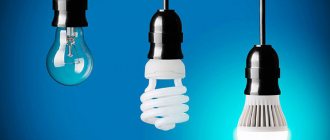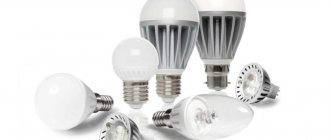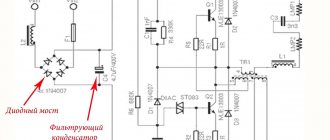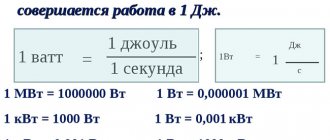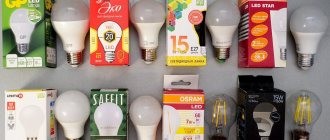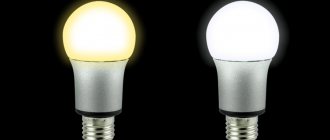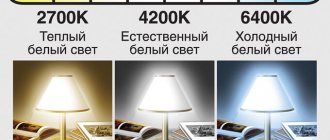Which ones are more economical?
The name “energy saving” has taken root in our country in relation to compact fluorescent lamps (CFLs). At the time of their widespread use, they were the most economical. Especially if you compare them with conventional incandescent lamps, housekeepers consume 3-4 times less energy. Later they began to “promote” LED light sources. They consume even less electricity, which means they are the most economical.
To decide whether energy-saving or LED lamps are better, you need to compare their parameters
To see the difference, look at the table. It shows the power consumption of LED, fluorescent lamps and those familiar to us with tungsten filament. They all have the same (or almost) lumen output, but as you can see, the power consumption is very different. A 3 W LED lamp is equal in light power to a 7 W energy saving lamp or a 20 W incandescent lamp. A 5 W diode lamp will replace a 12-13 watt “housekeeper” or a 40 watt incandescent. These are averaged data, since the indicators vary somewhat among different manufacturers, but, in general, the proportions remain the same.
| Incandescent lamps | Luminescent and energy saving | LED | Light flow |
| 20 W | 5-7 W | 2-3 W | 250 lm |
| 40 W | 10-13 W | 4-5 W | 400 lm |
| 60 W | 15-16 W | 6-10 W | 700 lm |
| 75 W | 18-20 W | 10-12 W | 900 lm |
| 100 W | 25-30 W | 12-15 W | 1200 lm |
| 150 W | 40-50 W | 18-20 W | 1800 lm |
| 200 W | 60-80 W | 25-30W | 2500 lm |
Just from this table alone it is easy to say that energy-saving or LED lamps are the most economical. But this is not all the advantages of LED technology. Let's talk about them further (as well as about the shortcomings, however).
Conclusion
When determining for yourself whether halogen lamps or LED lamps are better, you need to start from the purpose of use. If you need a lamp for a room where light is constantly needed and the lamps are almost never turned off, then it is better to resort to using LEDs. They place little load on the electrical system and consume little power. But it is worth remembering that they have a narrowly directed flow of light, so you need to buy several copies. Even then, their frequent use will be cheaper than using halogen-based lamps.
A halogen lamp will perform better in rooms where light is consumed less frequently. It is quite fragile, so it is better not to use it in table or floor lamps in children's rooms. It will well illuminate the pantry, bedroom, laundry room, closet. The compactness of the lamps makes them ideal for suspended ceilings.
Life time
If we talk about service life, the average for energy-saving ones is 10,000 hours. For LEDs this figure is higher: on average - 30,000 hours, but there are requests from manufacturers for 50-60 thousand hours of operation.
It seems that LED lamps are the leaders here, but there is one nuance. Both technologies have a rather significant drawback: over time, their glow intensity gradually decreases. The so-called “burnout” occurs. In this regard, it is worth focusing not on the stated operating time, but on the warranty period. It more accurately reflects the actual position. After all, if something happens to the lamp at this time, the manufacturer will have to replace the device with a new one. The less often such cases happen, the better. That is why manufacturers tend to underestimate the warranty period, since they bear financial responsibility.
It is better to compare not the working resource, but the warranty period
And if you compare energy-saving and LED lamps in terms of warranty period, there is also a difference. For LEDs the average is 3 years, for housekeepers - 1 year. There are more/less, but these are specific. So here, too, when comparing whether energy-saving or LED lamps are better, the best is LED technology.
Preparing for testing
First, I had to remake a built-in tester to measure the real power that light bulbs consume: attach a socket and plug to it to connect a lamp through it.
I bought a socket for modifying the built-in tester at OBI. The power cord from the computer was available. The basis for the device was a piece of 20 mm board. Socket and tester. Photo by the author
The network cable will be fixed to the board with a homemade galvanized clamp. We bend a rectangle of tin to the shape of the wire.
We make a clamp from tin. Photo by the author
We drill holes for screws with a diameter of 3 mm.
We drill holes with a Greenworks cordless screwdriver. Photo by the author
We also make a couple of clamps to fix the built-in tester itself to the board.
Galvanized clamps. Photo by the author
The socket is secured to the base with two screws. The network cable and the tester are fixed with tin clamps. We connect the power cable and socket to the tester.
We install the socket and tester. Photo by the author
Connect the device to the network. The tester worked - connected correctly. You can start checking the parameters of the light bulbs.
The tester is assembled, the tester is working. Photo by the author
Dimensions and appearance
Everyone knows the type and size of energy-saving lamps. This is a tube with a phosphor twisted into a complex spiral. The most compact ones can fit into a medium-sized lampshade, but in most cases they stick out from ordinary lamps, and with built-in ones they don’t look so great at all.
Approximate size difference between an LED and an energy-saving CCL lamp of the same luminous power
LED lamps can have very small sizes. A three-watt crystal can be made in the form of a circle with a diameter of 1.5-2 cm. And this is the equivalent of an energy-saving device of 7 W, which has a minimum size of 32 * 79 mm. Such miniature sizes of LEDs make it possible to make recessed lamps with a very small thickness - 2 cm or less. And this is with a radiator to remove the heat that the LEDs emit during operation. Such small sizes allow them to be built into furniture or to lower suspended and suspended ceilings to a very small height.
This is what recessed luminaires with LEDs look like
If we talk about the more familiar format - with a flask, then the shape and size of the flask can be completely different. This part is optional - the LED does not require a vacuum or a specific gas environment. So this is rather a tribute to tradition. There are bulbless lamps that are called “corn” lamps for their characteristic appearance. Their service life is determined by the quality of the LEDs, and not by the integrity of the shell, which, in fact, does not exist. You can even assemble lighting altogether from individual LEDs on a metal radiator plate or even without it. In general, the size and appearance of LED lamps may vary. And here, when deciding whether energy-saving or LED lamps are better, we certainly come to the conclusion that LED lamps are better - they can be almost invisible, and can have any shape and size.
Is it possible to distinguish a high-quality lamp from a low-quality one by visual signs?
They can even be distinguished by their weight. As a rule, there is no aluminum “glass” at the base of cheap plastic lamps, and the driver board is equipped with a minimum of components. That's why they are lighter.
Also pay attention to how the lamp parts are processed, whether there are any burrs from casting on the plastic, or scratches on the bulb. Often, cheap lamps have a bulb mounted on silicone and it is easy to separate it from the base of the lamp, which is very bad from the point of view of electrical safety.
In good quality lamps, the bulb is firmly connected to the base; it is not possible to open it without damage. In filament lamps, it is worth looking at the position of the “tree” - the leg on which the filaments themselves are soldered: in cheap lamps it can be crooked.
In addition, we advise you to choose a lamp not by power, but by luminous flux, since with cheap lamps, high power can mean low luminous flux.
Convenience and safety of use
Everyone knows that in fluorescent lamps the tubes are filled with phosphor, which begins to glow under certain conditions. It takes some time to create these conditions. Sometimes it is almost unnoticeable, and sometimes the delay after turning on can be a second or even a little more. This is not the most pleasant phenomenon to put up with. LED lamps light up immediately after voltage is applied. They are certainly better at this.
Today, more and more people are trying to make lighting with the ability to change the light intensity. This can be achieved either by a complex circuit with a large number of switches, or by installing a dimmer - a small device that allows you to smoothly change the level of glow. But the fact is that not all lamps can work with a dimmer. Energy savers cannot. They need a certain voltage level and its shape, and the dimmer distorts the shape. But some LED lamps can work with this device. Just look for dimmable ones when choosing LED bulbs. This ability is indicated in the technical specifications. The downside is that such light sources with equal characteristics are more expensive.
Table for comparing LED and energy-saving lamps
Another point in favor of LED lamps. Their flask (if there is one) is made of impact-resistant plastic. Energy-saving fluorescent lamps are made of glass. Moreover, damage to the tube is fatal - the light source stops working. In addition, some (cheap) housekeepers contain mercury vapor, so a damaged glass tube with phosphor can cause serious harm to health. This also leads to difficulties with recycling - special enterprises are needed to recycle such lighting devices.
And the last point regarding ease of use - it is impossible to restore either an incandescent lamp or a fluorescent lamp after failure. If damaged, they completely lose their functionality. LED lamps usually consist of a number of crystals located on the body. When one or more crystals fail, the luminous flux decreases, but light is still emitted, albeit in smaller quantities. In addition, if you wish and know how to use a soldering iron, you can replace burnt out elements, restoring their previous brightness.
So, when deciding whether energy-saving or LED lamps are better in terms of ease of use, we see that LED lamps are more practical and safe.
Final comparison table
Rice.
4: comparison of characteristics Below are comparison tables for both types of lamps, from which the advantage of LED lighting devices is clearly visible.
| Comparison parameter | Incandescent lamps | LED bulbs |
| Efficiency | 8 – 10 Lm/W | 90 – 120 Lm/W |
| Heat dissipation | 150 – 250 ºС | No more than 50 ºС |
| Efficiency | 5 – 15% | 90% |
| Lifetime | 1000 hours | 50,000 hours |
| Sensitivity to temperature changes | Available on some models | absent |
| Instant response when switched on | Instantly | Some models have a delay due to the operation of electronics |
| Safety in case of destruction | Scattered fragments | Safe |
| Mechanical strength | Afraid of blows and pressure | Not afraid, can work even without a flask |
Prices and yet what is better...
Everyone knows that LED lamps are more expensive. This is perhaps the only point where fluorescent lamps are ahead. But today the price difference is not as great as before. They are already almost equal. If we take, for example, light sources from the same manufacturer with the same equivalent (or almost the same) in relation to incandescent lamps, then the prices are almost identical.
Here, even the LED price is lower. True, the color temperature is different...
For example, lamps from Camelion (Chamelion). Energy saving lamp - LH15-FS-T2-M/864/E14 is the equivalent of a 75 W incandescent lamp, costs 160-225 rubles. LED lamp - Camelion LED8-C35/830/E27 (also equivalent to 75 W incandescent) - 170-230 rubles. Both series are basic, without any special bells and whistles, and if you take into account the savings on electricity (8 W versus 15 W) and service life (10,000 hours and 30,000 hours) and all the other “goodies”, then even the question “which is better is energy-saving or LED lamps" does not occur. The solution is probably clear - LED lights are more economical, easy to use and durable. They are best installed instead of incandescent lamps.
But a lot of information has recently appeared in the press and on the Internet that LEDs are harmful - they emit a harmful spectrum and flicker. There is no confirmed data about the spectrum, but luminescent ones flicker, flicker. But they always flicker, and there are LEDs without ripples, they just cost much more. In general, the decision is yours.
How to recycle lamps?
Many electrical appliances require special disposal. For example, fluorescent, sodium, halogen and metal halide devices contain mercury, which is harmful to nature and human health. Therefore, they cannot be disposed of as household waste by simply throwing them in the trash. They should be taken to special recycling centers.
LED lamps, classic and retro incandescent lamps do not contain mercury and other harmful substances. Therefore, they can be thrown into solid waste bins.
Advice! Although LEDs and incandescent bulbs are safe, you can recycle them in a way that is good for nature. To do this, hand over broken lamps to a recycling and recycling facility.
Manufacturers
Since LED lamps appeared on store shelves relatively recently, it is still difficult to determine which manufacturer is the leader.
When comparing different brands, we can mention OSRAM, PHILIPS. But IKEA lighting devices have also proven themselves well. Domestic manufacturers are also not lagging behind, for example the ERA and COSMOS brands. It is definitely impossible to say that all Chinese manufacturers produce low-quality goods. There are also quite reputable Chinese companies on the market. The choice is yours.
It is not advisable to purchase products with a long warranty period from online stores. It is possible to replace a low-quality product, but it will require a lot of effort. Therefore, it is better to purchase lamps in a retail store.
So, we can conclude that it is better to give preference to LED lamps. In addition to saving energy, they also have a number of advantages: durability, variety of types, safety, and environmental friendliness. But, however, the choice is a personal matter for everyone.
Heat dissipation
The second, no less important point of comparison between LED lamps and incandescent lamps is the heat transfer from the product. The glass bulb of an incandescent lamp can heat up to 250 degrees (although the temperature is usually around 170). That is why such products are fire hazardous, and it is not recommended to use them when installing electrical wiring in a wooden house. In addition, Ilyich bulbs are difficult to unscrew from the socket if they have been working for a long time before (you can get burned). LEDs in this regard have proven themselves better than all existing options. Their maximum heating temperature does not exceed 50 degrees, which allows them to be used in any room.
